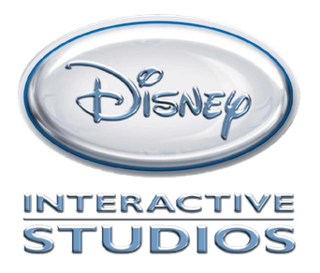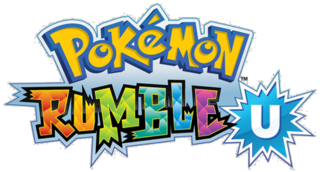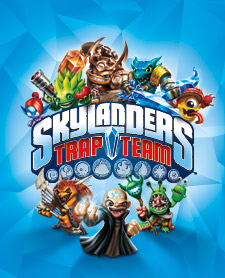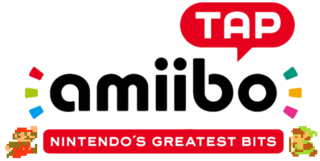
R.O.B. is a toy robot accessory for the Nintendo Entertainment System (NES). It was launched in July 1985 as the Family Computer Robot in Japan, and October 1985 as R.O.B. in North America. Its short lifespan yielded only two games in the Robot Series: Gyromite and Stack-Up.

Disney Interactive Studios, Inc. was an American video game developer and publisher owned by The Walt Disney Company through Disney Interactive. Prior to its closure in 2016, it developed and distributed multi-platform video games and interactive entertainment worldwide.

Skylanders: Spyro's Adventure is an 3D action-adventure platform game and the first video game in the Skylanders series. It is played using with toy figures that interact with it through a "Portal of Power" that reads their tag through NFC.

Skylanders is a toys-to-life action-adventure video game franchise published by Activision. Skylanders games are played by placing a character's figure on the "Portal of Power", a device that reads its tag using NFC and "imports" them into the game as a playable character.

Skylanders: Giants is a 2012 video game in the Skylanders series and a direct sequel to the 2011 game Skylanders: Spyro's Adventure. It features the voices of Kevin Michael Richardson, Greg Ellis, Peter Lurie, Steve Blum, Dave Wittenberg, Carlos Alazraqui, Kevin Sorbo, Bobcat Goldthwait, Patrick Seitz and Julie Nathanson. As the title suggests, it features larger Skylanders known as "Giants", along with other new gameplay mechanics. 16 new Skylanders were introduced, including 8 "Giants": Bouncer, Crusher, Eye-Brawl, Hot Head, Ninjini, Swarm, Thumpback, and Tree Rex.

Disney Infinity is a 2013 toys-to-life action-adventure game published by Disney Interactive Studios. It was announced on January 15, 2013. The game used collectible figurines that were then synchronized with the game, unlocking characters from Disney and Pixar properties that interact and go on adventures. The game was released for Xbox 360, PlayStation 3, Wii, Wii U, and Nintendo 3DS in August 2013. A PC version of Toy Box was also released on November 14, 2013. The game had a budget approaching $100 million. A sequel, Disney Infinity 2.0, was released on September 23, 2014. The third edition, Disney Infinity 3.0, was released on August 30, 2015, and introduced support for the Apple TV. This game was also later released on Microsoft Windows in 2013.

Skylanders: Swap Force is a 2013 platform game developed by Vicarious Visions and Beenox and published by Activision. It is the third main game in the Skylanders video game and toy franchise, following 2012's Skylanders: Giants, which was a direct sequel to 2011's Skylanders: Spyro's Adventure.

Pokémon Rumble U is a 2013 action video game in the Pokémon series available on the Wii U eShop developed by Ambrella and published by The Pokémon Company and Nintendo. It is the successor to the 2011 3DS game Pokémon Rumble Blast. It features all Pokémon from the first five generations. Up to 100 Pokémon and 4 players are able to play at the same time. It is the first Wii U game to utilize the Wii U GamePad's near-field communication (NFC) function. It was released in Japan on April 24, 2013, in Europe on August 15, 2013, and in North America on August 29, 2013.
Prodigy Tactics is a tactical role-playing video game developed by Hanakai Studio. The game features figurines representing characters in the game and uses cards to control their behaviors, such as attacking. Both cards and figurines are placed on a game board, with their position on the board influencing their powers and abilities. After an initial release date set in 2015 and not in 2016, the studio announced that Prodigy's release would be delayed due to an upgrade of its gameplay system. A Kickstarter campaign to fund the game's alpha and beta phases began in April 2014, with a $100,000 funding goal. It reached its goal in just three days, eventually collecting $200,000 from over 1,000 backers. An incomplete version of the game was released in September 2018, physical goods from the Kickstarter campaign remain unfulfilled.

Skylanders: Trap Team is a 2014 3D platform game developed by Toys for Bob and Beenox and published by Activision. It is the fourth installment in the Skylanders video game franchise and was released on October 2, 2014, in Australasia, October 5, 2014 in North America, and October 10, 2014, in Europe, for release on Android and iOS mobile platforms, PlayStation 3, PlayStation 4, Wii, Wii U, Xbox 360, Xbox One, and Nintendo 3DS. It is the sequel to Skylanders: Swap Force, and features the voices of Fred Tatasciore, Billy West, John DiMaggio, Matthew Moy, Laura Bailey, Alex Ness, John Paul Karliak, Matthew Yang King, and Richard Horvitz.

Disney Infinity 2.0 is a 2014 toys-to-life action-adventure game published by Disney Interactive Studios. It is the sequel to Disney Infinity (2013) and was announced on April 8, 2014. The game was released on September 23, 2014, in North America, September 19, 2014, in the United Kingdom, September 18, 2014, in Australia and the rest of Europe for iOS, PlayStation 3, PlayStation 4, Wii U, Microsoft Windows, Xbox 360, Xbox One, and PlayStation Vita on May 9, 2015.
Amiibo is a toys-to-life platform by Nintendo, which was launched in November 2014. It consists of a wireless communications and storage protocol for connecting figurines to the Wii U, Nintendo 3DS, and Nintendo Switch video game consoles. These figurines are similar in form and functionality to that of the Skylanders, Disney Infinity and Lego Dimensions series of toys-to-life platforms. The Amiibo platform was preannounced to potentially accommodate any form of toy, specifically including general plans for future card games. Amiibo use near field communication (NFC) to interact with supported video game software, potentially allowing data to be transferred in and out of games and across multiple platforms.

Disney Infinity is an action-adventure sandbox toys-to-life video game series developed by Avalanche Software. The setting of the series was a giant customizable universe of imagination, known as the Toy Box, populated with toy versions of iconic Disney, Pixar, Marvel and Star Wars characters.

Lego Dimensions is a Lego-themed action-adventure platform crossover video game developed by Traveller's Tales and published by Warner Bros. Interactive Entertainment, for the PlayStation 4, PlayStation 3, Xbox One, Xbox 360, and Wii U. It follows the toys-to-life format, in that the player has Lego figures and a toy pad that can be played within the game itself where it features characters and environments from over 30 different franchises. The Starter Pack, containing the game, the USB toy pad, and three minifigures, was released in September 2015, while additional level packs and characters were released over the following two years.

Disney Infinity 3.0 is a 2015 toys-to-life action-adventure game published by Disney Interactive Studios for Microsoft Windows, PlayStation 3, PlayStation 4, Wii U, Xbox 360, Xbox One and Apple TV, and is the third and final installment in the toys-to-life Disney Infinity series. It was developed by Avalanche Software and Heavy Iron Studios with addition help from Ninja Theory, Studio Gobo, Sumo Digital, and United Front Games. It is the sequel to Disney Infinity 2.0 (2014). In contrast to its predecessor, which focused on Marvel Comics characters and playsets, 3.0 has a focus on the Star Wars franchise. The game was announced on May 5, 2015, and was released on August 28, 2015 in Europe and on August 30, 2015 in North America.

Skylanders: SuperChargers is a role-playing platform video game and the fifth installment of the Skylanders series. It was developed by Vicarious Visions and Beenox and published by Activision. It was released on September 20, 2015, for PlayStation 3, PlayStation 4, Wii U, Xbox 360, Xbox One, and was released on October 18, 2015, for iOS. Skylanders: SuperChargers Racing was released as a standalone title for Wii and the Nintendo 3DS on the same date, and focuses on racing. A sequel, Skylanders: Imaginators, was released in October 2016.

Amiibo Tap: Nintendo's Greatest Bits, known as Amiibo Touch & Play: Nintendo Classics Highlights in the PAL regions, was an application developed and published by Nintendo for the Wii U's Nintendo eShop in 2015. The application was used to play demos of 30 popular Nintendo Entertainment System and Super Nintendo Entertainment System video games by scanning, Amiibo figurines, Nintendo's toys-to-life series of products.

Skylanders: Imaginators is a 2016 toys-to-life 3D platform game developed by Toys for Bob and published by Activision. It is the sixth installment of the Skylanders series, a successor to Skylanders: SuperChargers, and was released for Nintendo Switch, PlayStation 3, PlayStation 4, Wii U, Xbox 360 and Xbox One. It allows players to create their own characters, known as Imaginators. The game received generally positive reviews, but its sales were below Activision's expectations. It is the sixth and most recent Skylanders game released on consoles.
Lego Super Mario is a Lego theme based on the platform game series Super Mario created by Japanese game designer Shigeru Miyamoto. It is licensed from Nintendo. The theme was first introduced in 2020. Since its release, the Lego Super Mario theme has received generally positive reviews.















